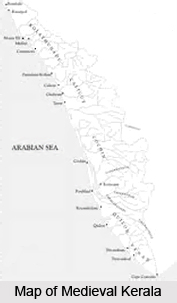 Local Administration in Medieval Kerala was managed mainly by the Nair caste. Every village has a Desavali except where the village was the private property of the Naduvali or the king. The chief could also acquire lands by purchase. The village council was usually held in the temples. Some of these temples were exclusively owned by the Nairs. The council was held at the beginning of every month for the administration of affairs connected with caste.
Local Administration in Medieval Kerala was managed mainly by the Nair caste. Every village has a Desavali except where the village was the private property of the Naduvali or the king. The chief could also acquire lands by purchase. The village council was usually held in the temples. Some of these temples were exclusively owned by the Nairs. The council was held at the beginning of every month for the administration of affairs connected with caste.
Dasavali was assisted by two Pramanis in police and judicial matters. The Pramanis were neither appointed nor hereditary. They belonged to the caste of Namboodiris and Nairs. However the other castes were not altogether excluded. Pramanis should be acceptable to both parties and if both attended they disposed off the matter without referring to the Desavali. This happens only if one of the parties wanted the case to be trialled in the village court or Panchayat. However if the defendant refused to attend, the Desavalis interfered and issued summons directing the Pramanis to decide the case in his court. The summons were obeyed but if it was refused the Desavali applied to the Naduvali, the chief, who settled the case himself. In case a village had no Pramani a case would be referred to a neighbouring village. The Desavali settled minor disputes. The major disputes were settled by the chief after a preliminary investigation was conducted by the Desavali. The Desavali and the Pramanis received fees for suits decided by them which were paid in equal shares by both the defendant and the plaintiff.
The Naduvali was the chief of the district. He enjoyed the same powers and privileges in the district as the Desavali. Naduvalis have to render military service to the king when they are called upon to do so. They were independent rulers in their respective district. These Nair lords held office by tenure. They also claimed to have derived their ownership from Parasurama. However all the Naduvalis were not equally powerful or rich. In some cases the Naduvali himself was the Desavali. There were also those who owned only one or two villages in the district. The line of demarcation between the Desavali and the Naduvali was so thin that at times a successful village headman played the role of a Naduvali. A person can be a Naduvali if he had at least one hundred Nairs attached to his range. In case he had less than hundred Nairs it made him a Desavali.
The Naduvalis differed in their status and position and this was indicated by their names. They might be swarupis, prabhus or matambis and styled Achan, Raimal or Nair. The tributary Rajas like Purakkad and Alangad or subordinate chiefs like the Kaimal of Koratty or Nambiar of Murianad were Naduvalis who possessed a high status and had the power of life and death over their subjects. The Prabhus were inferior to Kaimals as they were denied this power. The matambis belonged to the third class of the Naduvalis who were petty chiefs with limited powers.
The Naduvali was the chief police and judicial officer of the district. He was the revenue officer. He was assisted by two accountants who kept the report of his collections and records of land transfer. He had a share of every division of the Raja`s revenue-customs, fines, and confiscation of the property and so on. Naduvalis had to pay certain fees to the King - a succession fee or purushantaram. They also had to pay an annual tribute or andukalcha and an annual contribution for special protection called rakshabhogam. The Naduvali was the military chief of his district who was bound to march at the head of his soldiers at the command of the Raja. He would be accompanied by the fighting men under their respective Desavalis. All the soldiers of the district were under his control. Even when he would go against the King custom did not permit the Raja to abolish his office or confiscate his estate. However the rebel would be punished.



















